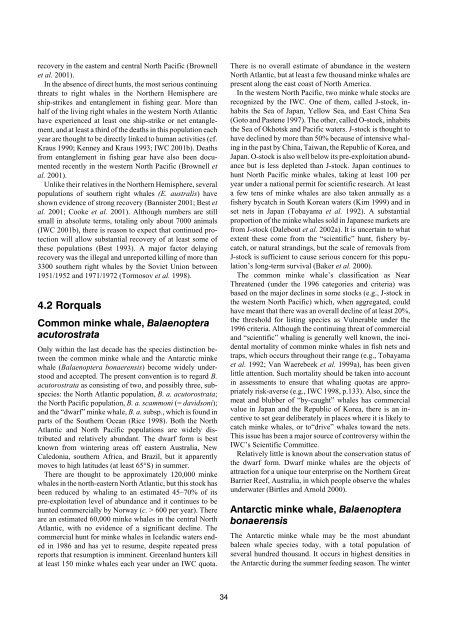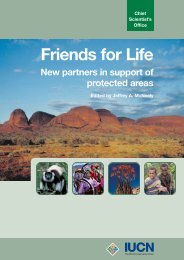Dolphins, Whales and Porpoises: 2002-2010 Conservation - IUCN
Dolphins, Whales and Porpoises: 2002-2010 Conservation - IUCN
Dolphins, Whales and Porpoises: 2002-2010 Conservation - IUCN
You also want an ePaper? Increase the reach of your titles
YUMPU automatically turns print PDFs into web optimized ePapers that Google loves.
ecovery in the eastern <strong>and</strong> central North Pacific (Brownell<br />
et al. 2001).<br />
In the absence of direct hunts, the most serious continuing<br />
threats to right whales in the Northern Hemisphere are<br />
ship-strikes <strong>and</strong> entanglement in fishing gear. More than<br />
half of the living right whales in the western North Atlantic<br />
have experienced at least one ship-strike or net entanglement,<br />
<strong>and</strong> at least a third of the deaths in this population each<br />
year are thought to be directly linked to human activities (cf.<br />
Kraus 1990; Kenney <strong>and</strong> Kraus 1993; IWC 2001b). Deaths<br />
from entanglement in fishing gear have also been documented<br />
recently in the western North Pacific (Brownell et<br />
al. 2001).<br />
Unlike their relatives in the Northern Hemisphere, several<br />
populations of southern right whales (E. australis) have<br />
shown evidence of strong recovery (Bannister 2001; Best et<br />
al. 2001; Cooke et al. 2001). Although numbers are still<br />
small in absolute terms, totaling only about 7000 animals<br />
(IWC 2001b), there is reason to expect that continued protection<br />
will allow substantial recovery of at least some of<br />
these populations (Best 1993). A major factor delaying<br />
recovery was the illegal <strong>and</strong> unreported killing of more than<br />
3300 southern right whales by the Soviet Union between<br />
1951/1952 <strong>and</strong> 1971/1972 (Tormosov et al. 1998).<br />
4.2 Rorquals<br />
Common minke whale, Balaenoptera<br />
acutorostrata<br />
Only within the last decade has the species distinction between<br />
the common minke whale <strong>and</strong> the Antarctic minke<br />
whale (Balaenoptera bonaerensis) become widely understood<br />
<strong>and</strong> accepted. The present convention is to regard B.<br />
acutorostrata as consisting of two, <strong>and</strong> possibly three, subspecies:<br />
the North Atlantic population, B. a. acutorostrata;<br />
the North Pacific population, B. a. scammoni (= davidsoni);<br />
<strong>and</strong> the “dwarf” minke whale, B. a. subsp., which is found in<br />
parts of the Southern Ocean (Rice 1998). Both the North<br />
Atlantic <strong>and</strong> North Pacific populations are widely distributed<br />
<strong>and</strong> relatively abundant. The dwarf form is best<br />
known from wintering areas off eastern Australia, New<br />
Caledonia, southern Africa, <strong>and</strong> Brazil, but it apparently<br />
moves to high latitudes (at least 65°S) in summer.<br />
There are thought to be approximately 120,000 minke<br />
whales in the north-eastern North Atlantic, but this stock has<br />
been reduced by whaling to an estimated 45–70% of its<br />
pre-exploitation level of abundance <strong>and</strong> it continues to be<br />
hunted commercially by Norway (c. > 600 per year). There<br />
are an estimated 60,000 minke whales in the central North<br />
Atlantic, with no evidence of a significant decline. The<br />
commercial hunt for minke whales in Icel<strong>and</strong>ic waters ended<br />
in 1986 <strong>and</strong> has yet to resume, despite repeated press<br />
reports that resumption is imminent. Greenl<strong>and</strong> hunters kill<br />
at least 150 minke whales each year under an IWC quota.<br />
34<br />
There is no overall estimate of abundance in the western<br />
North Atlantic, but at least a few thous<strong>and</strong> minke whales are<br />
present along the east coast of North America.<br />
In the western North Pacific, two minke whale stocks are<br />
recognized by the IWC. One of them, called J-stock, inhabits<br />
the Sea of Japan, Yellow Sea, <strong>and</strong> East China Sea<br />
(Goto <strong>and</strong> Pastene 1997). The other, called O-stock, inhabits<br />
the Sea of Okhotsk <strong>and</strong> Pacific waters. J-stock is thought to<br />
have declined by more than 50% because of intensive whaling<br />
in the past by China, Taiwan, the Republic of Korea, <strong>and</strong><br />
Japan. O-stock is also well below its pre-exploitation abundance<br />
but is less depleted than J-stock. Japan continues to<br />
hunt North Pacific minke whales, taking at least 100 per<br />
year under a national permit for scientific research. At least<br />
a few tens of minke whales are also taken annually as a<br />
fishery bycatch in South Korean waters (Kim 1999) <strong>and</strong> in<br />
set nets in Japan (Tobayama et al. 1992). A substantial<br />
proportion of the minke whales sold in Japanese markets are<br />
from J-stock (Dalebout et al. <strong>2002</strong>a). It is uncertain to what<br />
extent these come from the “scientific” hunt, fishery bycatch,<br />
or natural str<strong>and</strong>ings, but the scale of removals from<br />
J-stock is sufficient to cause serious concern for this population’s<br />
long-term survival (Baker et al. 2000).<br />
The common minke whale’s classification as Near<br />
Threatened (under the 1996 categories <strong>and</strong> criteria) was<br />
based on the major declines in some stocks (e.g., J-stock in<br />
the western North Pacific) which, when aggregated, could<br />
have meant that there was an overall decline of at least 20%,<br />
the threshold for listing species as Vulnerable under the<br />
1996 criteria. Although the continuing threat of commercial<br />
<strong>and</strong> “scientific” whaling is generally well known, the incidental<br />
mortality of common minke whales in fish nets <strong>and</strong><br />
traps, which occurs throughout their range (e.g., Tobayama<br />
et al. 1992; Van Waerebeek et al. 1999a), has been given<br />
little attention. Such mortality should be taken into account<br />
in assessments to ensure that whaling quotas are appropriately<br />
risk-averse (e.g., IWC 1998, p.133). Also, since the<br />
meat <strong>and</strong> blubber of “by-caught” whales has commercial<br />
value in Japan <strong>and</strong> the Republic of Korea, there is an incentive<br />
to set gear deliberately in places where it is likely to<br />
catch minke whales, or to“drive” whales toward the nets.<br />
This issue has been a major source of controversy within the<br />
IWC’s Scientific Committee.<br />
Relatively little is known about the conservation status of<br />
the dwarf form. Dwarf minke whales are the objects of<br />
attraction for a unique tour enterprise on the Northern Great<br />
Barrier Reef, Australia, in which people observe the whales<br />
underwater (Birtles <strong>and</strong> Arnold 2000).<br />
Antarctic minke whale, Balaenoptera<br />
bonaerensis<br />
The Antarctic minke whale may be the most abundant<br />
baleen whale species today, with a total population of<br />
several hundred thous<strong>and</strong>. It occurs in highest densities in<br />
the Antarctic during the summer feeding season. The winter






